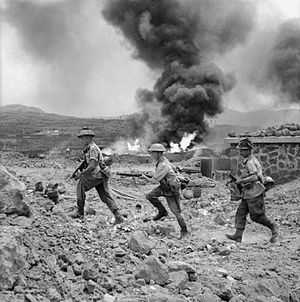Operation Corkscrew
| Operation Corkscrew | |||||||
|---|---|---|---|---|---|---|---|
| Part of Allied invasion of Sicily | |||||||
 British soldiers advancing inland during Operation Corkscrew. | |||||||
| |||||||
| Belligerents | |||||||
|
|
| ||||||
| Commanders and leaders | |||||||
| Walter Clutterbuck | Gino Pavesi | ||||||
| Strength | |||||||
| 14,000 | 12,000 | ||||||
| Casualties and losses | |||||||
| Light |
Heavy All surrendered | ||||||
Operation Corkscrew was the Allied invasion of the Italian island of Pantelleria (between Sicily and Tunisia) on 11 June 1943. There had been an early plan to occupy the island in late 1940 (Operation Workshop),[1] but this was aborted when the Luftwaffe strengthened the Axis air threat in the region.[2]
The Allied focus returned to Pantelleria in early 1943. The radar installations and airfield on the island were seen as a real threat to the planned invasion of Sicily. The Italian garrison on the island was 12,000 strong in well-entrenched pillboxes and 21 gun batteries of a variety of calibres. In addition, there was an opportunity to assess the impact of bombardment upon heavily fortified defences.[3] It was decided to see if the island could be forced into submission by aerial and naval bombardment alone. Failing this, an amphibious invasion was planned for 11 June.
Starting in late May, the island was subjected to steadily increasing bombing attacks. In early June, the attacks intensified and 14,203 bombs amounting to 4,119 tons were dropped on 16 Italian batteries. On 8 June, a Royal Navy task force of five cruisers, eight destroyers and three torpedo boats carried out a bombardment of the main port on the island. The engagement was observed by General Eisenhower and Admiral Cunningham from the flagship HMS Aurora.[3][4] From 8 May to 11 June 5, 285 bombing sorties were flown by fighter-bombers, medium and heavy bombers, dropping a total of 6,202 tons of bombs on the island.[3]
Two demands for the garrison to surrender went unanswered and, on 11 June, the amphibious assault went ahead. About an hour before the landing craft reached the beaches, the accompanying ships opened fire. Unknown to the attackers, the commander of the garrison on Pantelleria had sought permission to surrender from Rome the previous evening and received it that morning.[3] When the first of the British Commandos landed, the Italians surrendered. Winston Churchill was to record later in his memoirs that the only British casualty was a man bitten by a mule.
An assessment by British analyst Professor Sir Solly Zuckerman reported that the defenses had been reduced to 47% effectiveness. The intense ten day air bombardment had substantially reduced the defenses. Out of 80 guns bombed, 43 were damaged (10 beyond repair). All control communications were destroyed, along with many gun emplacements, ammunition stores and air raid shelters. The ease of the operation led to an optimistic assessment of the effectiveness of bombing, which was not always borne out in practice.
The Italian garrisons on other nearby islands (Lampedusa and Linosa) quickly fell. This cleared the way for the invasion of Sicily a month later.
References
- ↑ Winston Churchill (1949). "Desert Victory". Their Finest Hour. Houghton Mifflin Company. p. 552. ISBN 0-395-41056-8.
- ↑ Winston Churchill (1950). "The Mediterranean War". The Second World War: The Grand Alliance. Houghton Mifflin Company. p. 52. ISBN 0-395-41057-6.
- ↑ 3.0 3.1 3.2 3.3 Rogers, Edith C. (1947). The Reduction of Pantelleria and Adjacent Islands, 8 May-14 June 1943. monograph 52. US Air Force, Air Force Historical Research Agency. Retrieved 30 March 2009.
- ↑ "The Evening Independent - Jun 11, 1943". Google News Archive. Retrieved 23 May 2013.